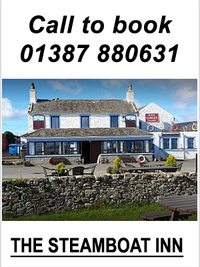Many thanks to
Michael & Shelly at
Coastguard's cottage for facilitating this camera's location and to
The Scottish Environment Protection Agency for capitally funding its installation. Carsethorn is situated within the Nith Estuary National Scenic Area, a highly regarded region known for its picturesque landscapes in Scotland. The area has a rich history deeply intertwined with the Solway Firth. To commemorate the village's significant role in the history and development of Dumfries, an oak "boat" bench has been installed in Carsethorn. During the late 17th and 18th centuries, as agricultural advancements were being made, a substantial number of people who worked on the land were displaced and chose to emigrate to America and Australia. Carsethorn's utilization as a harbor was first recorded in 1562 when a ship loaded for a voyage to La Rochelle and Bordeaux in France. However, the prominence of Carsethorn as a trading harbor diminished after 1747 when Glencaple, located on the opposite shore, underwent development. Nonetheless, some ships continued to use Carsethorn as a harbor, and in the 1790s, large ships traveling from the Baltic offloaded timber cargoes here, as the upper reaches of the Nith River were inaccessible to them. In the 1840s, the Wooden Pier was constructed to serve steamships engaged in trade with Liverpool and Glasgow.The village of Carsethorn was established by Danish Vikings as a fishing and coastal trading port, taking advantage of the sandy shore that provided a safe area for beaching ships during mid-tide on a falling tide. At low tide, the ships could be unloaded or loaded from carts, and then floated off during the next rising tide. During a time when inland roads were mere rutted tracks, sea transportation was the primary means for freight and passenger traffic. However, this began to change with the advent of road improvements by figures like Telford and MacAdam in the early 1800s.Over time, the channel of the River Nith gradually shifted closer to Carsethorn until the deep-water channel was near the shore. Carsethorn was first documented as a port in 1562 when a ship was loading for Rochelle and Bordeaux. Later, the affectionately nicknamed "Carse" served as an outport for Dumfries, with larger ships anchoring in Carse Bay before unloading their cargo. Substantial trade occurred throughout the 17th, 18th, and 19th centuries, primarily coastal trade to ports on both sides of the Solway, as well as to Ireland and the Isle of Man.In 1760, a local young man named John Paul Jones, who would later gain fame as the founder of the American Navy, sailed from Carsethorn to England at the age of just 13. After a career in merchant shipping, he joined the Revolutionary Navy and achieved a notable victory by defeating the English frigate 'Serapis' off Flamborough Head. During one of his cruises in the Irish Sea, he burned coal ships at Whitehaven and raided the home of the Earl of Selkirk near Kirkcudbright.During the late 18th and early 19th centuries, Carsethorn witnessed a significant wave of emigration to the American and Australian colonies. Newspaper advertisements from that time period regularly featured sailings of emigrant ships departing from Carsethorn.A darker aspect of Carsethorn's history emerged with the transportation of convicts to Australia. These individuals were marched down from Dumfries and housed in the barracks, which later became a warehouse, situated at the river's edge. The whitewashed building still stands to the south of the bus stop in Carsethorn.The coastal trade reached its zenith in the late 1840s, with nearly 25,000 tons of goods entering the river. Steamboats such as the 'Countess of Nithsdale' maintained longstanding connections with Liverpool. Reportedly, in 1850 alone, 10,000 people emigrated to North America, 7,000 to Australia, and 4,000 to New Zealand through the 'Carse,' departing from the jetty constructed in 1840 by the Nith Navigation Commission and utilized by the Liverpool Steam Packet Company. The remnants of that jetty still stand beside the deep-water channel at the northern end of Carsethorn. It was a triangular structure, with its longest face serving as a pierhead for steamers to dock alongside.By the early 1900s, very little trade remained in Carsethorn.Today, Carsethorn, once known for its smuggling activities and involvement in salt, tea, wine, and the escape of Jacobites, is characterized by a line of houses and bungalows along the shoreline.Additionally, a Farson streaming webcam is strategically positioned to monitor tidal breaches during storms, high tides, and potential flooding oof the village..







